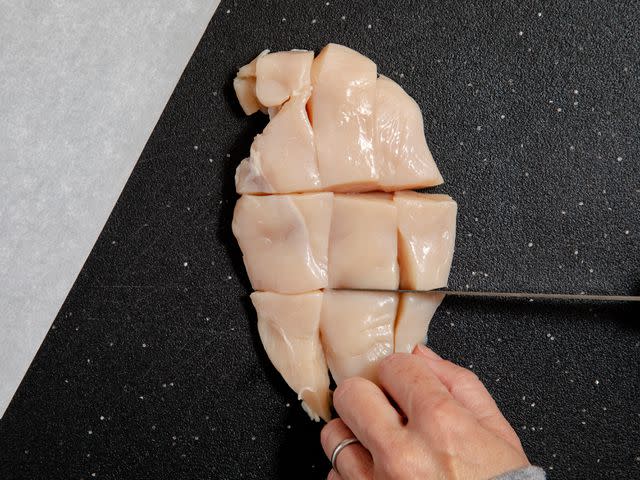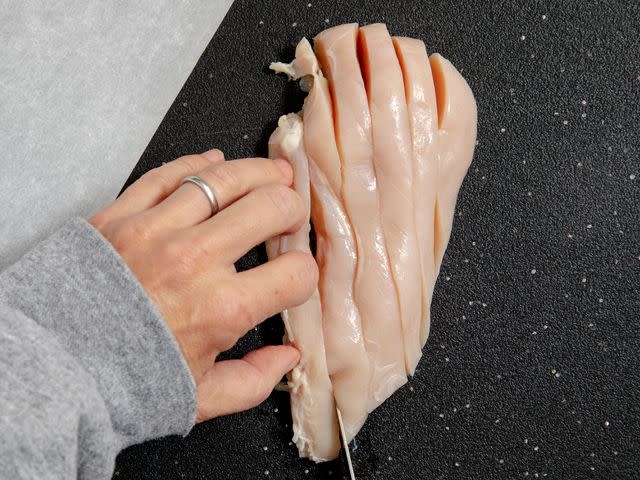The Foolproof Method for Getting Tender Chicken Every Time
This simple hack will change the way you prep chicken forever.

Sara Haas/Allrecipes
If you know anything about skinless, boneless chicken breast, you know that not preparing it correctly will result in something that's flavorless, dry, and chewy. The lack of fat and skin is why chefs often prefer not to work with this part of the bird, but as a recipe developer, I know that home cooks love this cut—and I like it too. I see the problems it presents as a fun challenge, one where I ask myself, “How can I turn this bland and often texturally unappealing food into something delicious?”
Chicken breast doesn't always have to be tough and dry. There are many ways to tenderize chicken breast, and among cooking experts, cutting seems to be the simplest method. Does it matter how you cut your boneless chicken breast? To clarify any confusion, I set out on a mission to see whether or not the key to perfectly juicy and moist chicken breast has to do with how it's cut.
What Is Cutting Against the Grain?
A popular way to cut steak is by cutting perpendicular to the long fibers running down the meat. This is called cutting against the grain, which cuts the fibers into shorter pieces, resulting in tender meat that’s easier to chew, and a much more enjoyable eating experience. Like beef and pork, poultry cuts are muscles with long fibers. Could we apply the same method to chicken?
Matt Moore, chef and author of "Butcher on the Block," confirms that slicing against the grain on boneless, skinless chicken is a good idea. He takes it a few steps further by cutting the breasts into cubes like those often used for kebabs. After removing the tenderloin, he cuts the remaining breast into six to nine equal-sized pieces. Next, he uses pressure—usually the heel of his palm or a mallet—to flatten the breast into an even shape. This helps with consistency he says, but it also tenderizes by breaking down the muscle fibers. “Cutting the breasts into squares provides a double entendre, if you will, by slicing both with and against the grain, while also opening up additional surface area for marinades and seasoning.”

Sara Haas
Moore's method of cubing the chicken breast.The Best Way to Cut a Chicken Breast
Intrigued, I gave both Moore’s method and the cutting against the grain method, a try. Here’s what happened. For Moore’s method, I did as instructed. I removed the tenderloin, then cut the remainder into nine equal-sized pieces. I used the heel of my hand to pound each piece into an even thickness, then set it aside while I got to work on the other chicken breast.
For the second breast, I sliced it lengthwise, against the grain, into six pieces. In addition to this, I had a "control" piece which was cut with the grain, or parallel to the lines in the meat. I seasoned all pieces with salt and pepper and a bit of Cajun spice before cooking in a seasoned cast-iron skillet.

Sara Haas
Simply cutting the chicken breast against the grain.The control piece was chewy and unpleasant as predicted, while both Moore’s method and simply cutting against the grain, resulted in juicy, fork-tender chicken. To be sure I wasn’t biased, I asked my mom to try each piece and tell me which one she preferred. The two breasts that were cut against the grain came out on top, with my mom claiming the control piece was far less tender and chewier than the others.
So, should you cut your boneless, skinless chicken breast against the grain? It seems like it’s a unanimous yes—especially if a tender and juicy chicken breast is what you're after. Of course, there are other methods for tenderizing, such as brining and marinating, but since you already have your knife out, why not try cutting chicken in a new way?
Read the original article on All Recipes.


